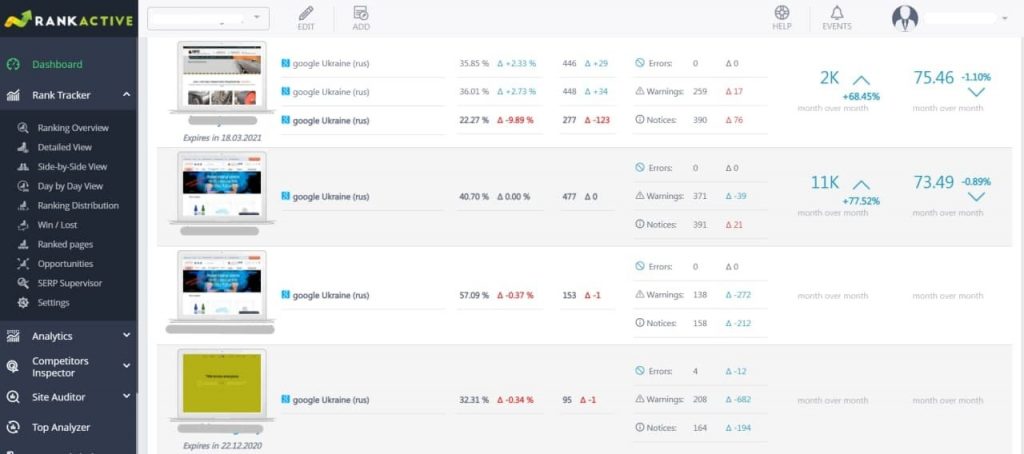How to Turn Your SEO Side Hustle Into a Lucrative Business
5 April 2021 Leave a comment ALL-HANDS SEO
Many of the most recognized companies once started as small side hustles. Steve Jobs was working night shifts at Atari while building the very first Apple computer in a garage. Mark Zuckerberg was developing Facebook in his spare time while studying at Harvard University. The CEO of Twitter, Jack Dorsey, was writing code at Odeo while creating a social media platform that would soon change the world.
And what do you do when you’re not at work?
If you’re reading this, we can assume you have an SEO side hustle and want to transform it into a lucrative business. You probably dream of quitting your dull nine-to-five job, becoming your own boss, and having more freedom. Is that right?
If so, this blog post is for you.
In the following paragraphs, you’ll find four valuable tips for turning your SEO side hustle into something bigger. Hopefully, this article will inspire you to stop procrastinating and start following your dream.
#1 Get a job in the industry
There are basically two things needed to launch a company. The first is money to cover startup costs, and the second is experience. You have to learn how SEO agencies operate, what products and services they offer, where they find customers, how much they pay their employees, and so on.
To kill two birds with one stone, consider getting a job in the industry. That way, you can learn from the experience of someone else’s company and earn money to get your business running.
Many successful entrepreneurs started this way. Steve Wozniak had worked as a computer engineer at Hewlett-Packard before launching Apple with Steve Jobs. The experience he had acquired helped him build Apple I, the company’s first commercially successful desktop computer.
Another good example is Michael Bloomberg. Before he founded Bloomberg L.P., Michael had worked at Salomon Brothers, the investment bank, where he gained knowledge of system development that would soon help him develop a new kind of computer terminal to display and distribute financial information.
We advise you to follow these entrepreneurs’ paths and also find a job in the industry. You can benefit from it, finding new valuable acquaintances. Moreover, you can even meet your future business partner there and launch your company together.
#2 Find a partner
 You don’t have to go alone. In fact, 72% of side hustlers start their companies with a partner.
You don’t have to go alone. In fact, 72% of side hustlers start their companies with a partner.
Two heads are better than one, as they say.
But why do most entrepreneurs prefer having a partner instead of going solo? There are several reasons:
- When you launch a company with a partner, you can assign responsibilities and split the workload, saving yourself from burnout.
- Two or more people thinking together can come up with better solutions. For example, a partner might help you decide what marketing strategies are right for your business, what prices you should set for your services, what employees you should hire, how much you should pay them, and so on. Having multiple perspectives on such important issues will help you make fewer mistakes.
- Launching a company with a partner, you share the cost of getting your business started. You also share all the business risks and expenses, decreasing the financial burden.
And last but not least, it’s easier to overcome difficulties when you have someone to back you up.
Nevertheless, whether you’re starting with a partner or solo, brace yourself as you’ll have to dedicate a great deal of time to turn your side hustle into a viable company.
#3 Be prepared to spend lots of time on your side hustle
Turning a side hustle into a business requires dedication. If you aim at success, be ready to dedicate almost every free minute to your side project.
But exactly how much time do you need to spend on your side hustle? At what point can you turn it into a profitable business?
Trying to answer these questions, Hiscox surveyed 400 US small business owners who first started their businesses as side hustles. What the company has discovered is pretty interesting.
According to the survey, most side hustlers spent 20 hours per week on their side projects while still employed full-time. It took them 19 months on average to quit their nine-to-five jobs. Also, most respondents managed to hire their first employees only seven months after leaving their full‑time jobs. And what’s more interesting, it took them three years on average to reach the same annual income as they had before.
The question is: are you ready to dedicate as much time to your side hustle?
While working nine-to-five and keeping your side hustle running is undoubtedly challenging, you should try your best not to burn the candle at both ends. Otherwise, you’ll wear out and lose your passion for SEO. To simplify your optimization routine and minimize workload, try automating any working process you possibly can.
#4 Use automation tools to decrease the workload
 When you’re just starting out, it’s not a big deal to manually do most of the work. But once you acquire many customers and manage dozens of projects daily, your working routine may turn into a living hell. To protect yourself from work overload, consider using advanced SEO tools. They will simplify your working routine and save you plenty of time.
When you’re just starting out, it’s not a big deal to manually do most of the work. But once you acquire many customers and manage dozens of projects daily, your working routine may turn into a living hell. To protect yourself from work overload, consider using advanced SEO tools. They will simplify your working routine and save you plenty of time.
The following example illustrates our point.
When one of our clients, let’s call him Jimmy, had twenty to thirty projects to manage daily, he was overwhelmed with work. Dealing with that many projects day after day was challenging and time-consuming. What’s more, Jimmy’s customers constantly contacted his SEO agency, asking about what was happening to their rankings.
 One day, Jimmy lost his patience and decided to hire more employees to deal with the ever-growing workload. However, it had only a temporary effect. The projects continued to pile up, and even ten employees weren’t enough to manage all of them.
One day, Jimmy lost his patience and decided to hire more employees to deal with the ever-growing workload. However, it had only a temporary effect. The projects continued to pile up, and even ten employees weren’t enough to manage all of them.
Exhausted, Jimmy desperately searched for a solution, until one of his employees introduced him to RankActive.
Since then, Jimmy has been a big fan of RankActive’s toolkit. He uses our tools because they help him keep his work organized and automate many of the tasks he had been doing manually. As Jimmy told us, his favorite feature is Dashboard as it enables him to see what’s going on with his customers’ websites at a glance.
 Jimmy also likes the Account Access feature. When his customers ask what is happening to their rankings, he provides access to our tools to let them take a look. In addition to that, Jimmy leverages our White Label feature, which enables him to set his brand logo and description in the software interface and give his customers the feel they’re using his agency’s own SEO tool. That helps Jimmy build strong customer loyalty.
Jimmy also likes the Account Access feature. When his customers ask what is happening to their rankings, he provides access to our tools to let them take a look. In addition to that, Jimmy leverages our White Label feature, which enables him to set his brand logo and description in the software interface and give his customers the feel they’re using his agency’s own SEO tool. That helps Jimmy build strong customer loyalty.
What also makes Jimmy’s SEO routine easier is that he uses RankActive to make monthly reports for his customers. You see, before he found our toolkit, he had made reports manually. Given that Jimmy usually had twenty to thirty projects, creating reports was an incredibly daunting task.
With RankActive, Jimmy can now create a report only once, and all the data in it updates automatically every day. That saves plenty of his time, allowing him to focus on attracting clients much more.
So if you’re also struggling with managing your SEO projects while being employed full-time, use our tools and make your working routine much more effortless.
Conclusion
As you can see, turning an SEO side hustle into a business requires plenty of time and effort. But no one said it would be easy. Work hard and be smart about decisions you make so that one day your dreams will come true. We believe in you and wish you good luck.
While turning your SEO side hustle into a lucrative business, use our SEO tools as they will help you automate many working processes, saving your time and effort.
Sign up to RankActive right now and test our toolkit for 14 days for free.
Tags: dashboard, RankActive, Reports, SEO tools, success story, White Label
Like this article? There’s more where that came from.
- 5 Questions to Ask Yourself Before Paying for Rank Tracking Software
- 5 Serious Mistakes Beginner SEOs Make and How to Fix Them
- Why We Use Google’s New Link Attributes and You Should Too
- Title and Description in 2021: Why Google Rewrites SEOs’ Meta Tags
- What We Should Learn From Google’s “About This Result” Feature

